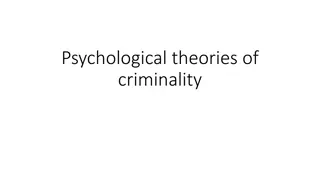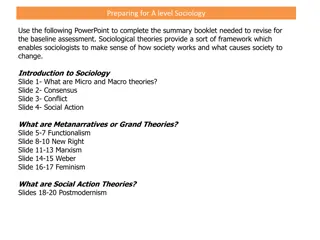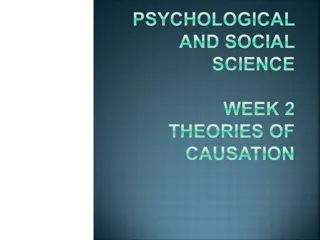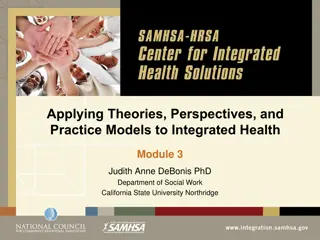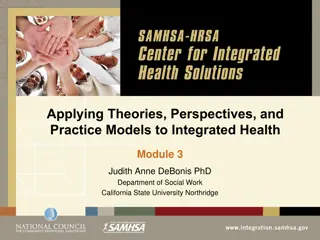
Leadership, Management, Innovation and Change in Social Care and Health
Explore the definitions of leadership, management, innovation, and change in the context of social care and health settings. Understand the importance of effective leadership and management for driving innovation and change to meet evolving needs and enhance services.
Download Presentation

Please find below an Image/Link to download the presentation.
The content on the website is provided AS IS for your information and personal use only. It may not be sold, licensed, or shared on other websites without obtaining consent from the author. If you encounter any issues during the download, it is possible that the publisher has removed the file from their server.
You are allowed to download the files provided on this website for personal or commercial use, subject to the condition that they are used lawfully. All files are the property of their respective owners.
The content on the website is provided AS IS for your information and personal use only. It may not be sold, licensed, or shared on other websites without obtaining consent from the author.
E N D
Presentation Transcript
Introduction to theories and models of leadership, management, innovation and change PE1S057 Theories and Frameworks for Leadership and Management in Social Care and Health
What do the following terms mean? - Leadership - Management - Innovation and change
For the purpose of this unit we will use the following definitions: Leadership Leadership is a set of qualities and ability to influence and inspire individuals and groups behaviours, actions and values to achieve a vision or set of goals. Leaders do not have to be in a formal leadership position to influence others. (Schein, 2017; Field and Brown, 2016; Stirk and Sanderson, 2012; Jones and Bennett, 2012)
Management Management can be about the planning, organisation, co- ordination and implementation of strategies and policies. The terms leadership and management are often used interchangeably but they are different. It is argued that you have to be good at leadership and management to be an effective leader. (Schein, 2017; Field and Brown, 2016; Stirk and Sanderson, 2012; Jones and Bennett, 2012)
Innovation and Change Innovation is the planned and effective introduction of change requiring the implementation of ideas that result in improvement. The critical part of this definition is that the intent of change (alteration or variation) is improvement. (Tjosvold et al. 2010, p.637)
Why do we need to lead and manage innovation and change in social care and health?
Why do we need to lead and manage innovation and change in social care and health? Some reasons include: - A need to ensure that our services respond to what individuals want in the present as opposed to the past - We are constantly having to do more with less , and so we need to be innovative in the way that we work.
- There is a need to comply with legislation and government policy in different ways doing things (that don t work) in the same way is likely to reap the same results, so perhaps try something different? - No one size fits all within service delivery and so innovation supports a need to co-design, develop and revise services in person centred ways that meet the needs of individuals.
Types of Leadership Theories Trait theories Personal qualities and personality traits that characterise an effective leader Behaviour theories These theories focus on the behaviour of leaders New paradigm leadership theories Leadership as an exchange between those leading and following based on a number of issues including pay and benefits but also emotions, relationships and a sense of belonging and common beliefs Situational leadership Leaders have to adapt their style of leadership in accordance with the situation they are in at the time
A closer look at situational leadership as a theory relevant to innovation and change Blanchard & Hersey s Situational Leadership Model (1982, 1997)
Situational Leadership Instead of using just one style, successful leaders change their leadership style based on the maturity of the people they are leading and the details of the task. This theory can be linked to the concept of leader and follower(s). For instance, the leader may place more or less emphasis on the task or more or less emphasis on their relationship with the people they are leading. This is to allow the job to be completed successfully.
Summary of four main styles of situational leadership to be used as appropriate to the situation and staff member or members Directing Leaders: Define the roles and tasks of the 'follower', and supervise them closely. Decisions are made by the leader and announced, so communication is largely one-way. Coaching Leaders: Define roles and tasks, but seeks ideas and suggestions from the follower. Decisions remain with the leader, but communication is much more two-way.
Supporting Leaders: Pass day-to-day decisions, such as task allocation and processes, to the follower. The leader facilitates and takes part in decisions, but control is with the follower. Delegating Leaders Are still involved in decisions and problem-solving, but control is with the follower. The follower decides when and how the leader will be involved.
Examples of change management theories - Lewin s model of change (1951) - Bridges Transition model (1991) - Kotter 8 step change model (1996)
A closer look at Lewins model of change (1951) as a theory that is relevant to innovation and change Referred to in Bowers (2011)
Unfreezing Determine what needs to change (why and how?) Ensure there is strong support from leadership and management (how?) Create the need for change (how?) Manage and understand doubts and concerns (how?)
Changing Identify the changes required (who, by when, how?) Involve individuals and communities in the change (including advocacy) why are we changing? What are the alternatives? What are the implications?
Changing Leadership and management of the change outlining the vision, managing fears, concerns, resistance and conflict, responding to different ways to implement the change Processes in the change, e.g. Equality Impact Assessment, project management, risk analysis and information sharing
Refreezing Embedding the change to make it permanent - this may be evident through the existence of a new building, service, change to practice or a change to staffing New ways of doing things, e.g. policies, procedures and methods of delivery such as out in the community instead of within a residential or organisational setting
New behaviours and attitudes, e.g. what can you do? as opposed to what can t you do? This reflects the ethos of the Social Services and Wellbeing (Wales) Act
References Bowers, B. (2011) Managing change by empowering staff. Available at: https://www.nursingtimes.net/download?ac=1236479 (Accessed: 1 February 2019). Bridges, W. (no date) Managing transitions by William Bridges. Available at: https://www.amazon.co.uk/Managing-Transitions-Making-Most-Change/dp/1857885414 (Accessed: 1 February 2019). Field, R. and Brown, K. (2016) Effective leadership, management and supervision in health and social care. 2nd edn. Thousand Oaks, California: Sage. Kotter, J. (1996) Leading change. Boston, Mass: Harvard Business School Press. Schein, E. (2017) Organizational culture and leadership. 5th edn. Electronic books [Online]. Available at: www.dawsonera.com (Accessed: 1 February 2019). Hersey P.K. and Blanchard, K. (1982) Management of organizational behavior, 4th edn. Prentice Hall, Englewood Cliffs, NJ. Hersey P. and Blanchard K. (1997) Management of organizational behavior: utilizing human resources. Prentice Hall, Englewood Cliffs, NJ.
References Jones, L. and Bennett, C. (2012) Leadership in health and social care. Oxfordshire; England. Electronic books [Online]. Available at: www.dawsonera.com (Accessed: 1 February 2019). Stirk, S. and Sanderson, H. (2012) Creating person-centred organisations, strategies and tools for managing change in health, social care and the voluntary sector. London; Philadelpia: Jessica Kingsley Publishers. Electronic books [Online]. Available at: www.dawsonera.com (Accessed: 1 February 2019). Tjosvold, D., Wong, A. and Wan, P. (2010) Conflict management for justice innovation and strategic advantage in organizational relationships , Journal of Applied Psychology, 40 (3), pp. 236-665. Wiley Online Library [Online]. Available at: http://onlinelibrary.Wiley.Com (Accessed: 1 February 2019).



